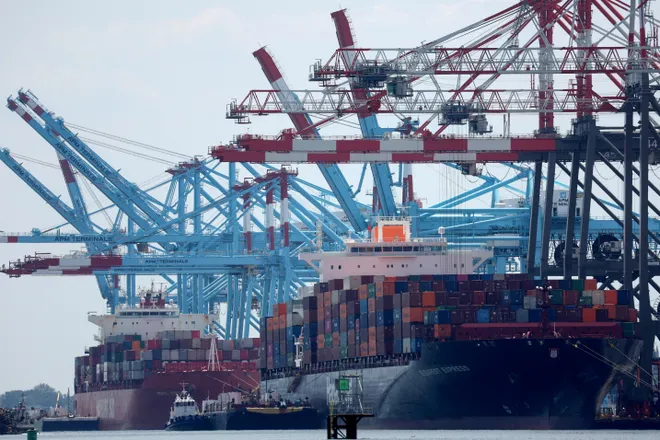Port workers strike at East Coast, Gulf ports sparks fears of inflation and more shortages
(This story was updated to correct a typo and add new information.)
Dockworkers at ports from Maine to Texas are officially on strike after the clock struck midnight with no new labor deal in hand.
Thirty-six East and Gulf coast ports shut down as 45,000 union workers walked off the job after labor negotiations over higher pay and protections against automation stalled between the International Longshoremen's Association (ILA) and the United States Maritime Alliance (USMX). The strike only exacerbates some temporary port closures in places like Florida, the Carolinas and Georgia in the wake of Hurricane Helene.
The ILA strike is the first at these ports since 1977 and has the potential to cost the economy up to $5 billion a day, upend holiday shopping for millions of Americans and dictate whether many small- and medium-sized businesses and farmers turn a profit or lose money this year, experts said.
“Every idle day that a ship does not get into the port costs money and sometimes a lot of money…that ultimately gets passed onto consumers,” said Stamatis Tsantanis, chairman and chief executive of shipper Seanergy Maritime and United Maritime, in a statement.
Length matters
Now that the strike is on, experts will turn their focus to how long the strike may last. Each day of the strike could cost the economy up to $5 billion a day as imports and exports are blocked, some economists estimated.
“It’s not just about the shutdown but also, about the recovery period and how long it takes to get things up back and running,” said Jonathan Gold, vice president of supply chain and customs policy at the National Retail Federation.
For each day of the strike, it takes about three to five days to clear the backlog and resume normal operations, he said. “The longer it goes, the more it gets compounded,” he said.
A port closure in 2002 went for 11 days before the Bush administration invoked the Taft-Hartley Act to force the ports to reopen. The Act allows the federal government to seek a court injunction against a strike to allow both parties to continue negotiations during an 80-day cooling off period. It took six months to recover from those 11 days, Gold said.
Despite many industry groups calling for intervention, the Biden administration said it doesn’t intend to invoke Taft-Hartley. Instead, it encouraged continued negotiations and said in a statement that it would carefully monitor supply chain disruptions and “respond swiftly to help minimize potential disruptions in the event of a prolonged strike by engaging extensively with the ports, state and local officials, industry, labor, ocean carriers, rail and trucking companies."
The state of work in America: Sign up for USA TODAY's The Daily Money newsletter for exclusive financial content.
What to expect:A port strike could cost the economy $5 billion per day, here's what it could mean for you

What’s affected by the strike?
Imports: With about half of U.S. ocean imports passing through the East and Gulf coast ports, a wide range of products are affected, including produce, cars, auto and machinery parts, clothing, pharmaceuticals, wine and spirits, holiday goods like toys, and seafood, experts said.
“Any strike that lasts more than one week could cause goods shortages for the holidays,” said Eric Clark, portfolio manager of the Rational Dynamic Brands Fund. “Retailers are running lean currently so inventory would get drawn down, and prices of shipping, and goods prices would go vertical for a period of time. We could get the kind of inflation for 6 months similar to or worse than peak inflation levels a year ago.”
Small and medium-sized businesses could suffer most, some said.
“Large businesses with dedicated procurement departments and considerable access to capital have been preparing for this strike for some time and many have ordered excess materials which they were able to finance with lower-cost debt,” said Ben Johnston, chief operating officer at small business lender Kapitus.
“Small businesses, however, are less likely to have been able to order early and in bulk and are less likely to obtain the capital required to order larger quantities of supplies in advance,” he said.

Exports: Businesses that sell products to international markets would suffer, experts said. For example, agricultural exporters of soybeans and poultry won’t be able to send their goods overseas and could end up losing market share, or worse, lose money because their goods are perishable, they said.
Jobs: Companies keeping lean inventories to keep costs low might have to shut down assembly lines amid a prolonged strike, for example, Gold said. This would come at a time when the job market is already cooling.
What are port workers demanding?
The ILA is seeking a 61.5% pay increase over six years, according to CNBC. It also wants protections against automation.
"They (USMX) don’t care about us," said ILA President Harold Daggett in a post on Monday. "They would love to see automation up and down the whole East and Gulf Coast, trust me when I tell you that if it was up to them, we would have no jobs."
On Monday, USMX said in a statement it had offered to increase wages by nearly 50%, triple employer contributions to employeeretirement plans, "strengthen our health care options, and retain the current language aroundautomation and semi-automation.”
Medora Lee is a money, markets, and personal finance reporter at USA TODAY. You can reach her at mjlee@usatoday.com and subscribe to our free Daily Money newsletter for personal finance tips and business news every Monday through Friday morning.
Disclaimer: The copyright of this article belongs to the original author. Reposting this article is solely for the purpose of information dissemination and does not constitute any investment advice. If there is any infringement, please contact us immediately. We will make corrections or deletions as necessary. Thank you.







